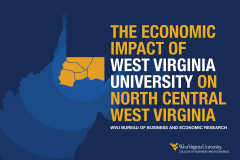West Virginia University plays a significant role in the economic success of north-central West Virginia, according to a new study. The operations of WVU’s main campus represented an annual economic impact in 2014 of more than $3.6 billion in the five-county region of north-central West Virginia.
The findings also indicated that more than 26,000 individuals – or 22 percent of the total workforce in the region – are employed by the University directly or indirectly through the University’s spending in the local economy.
WVU President Gordon Gee hosted a gathering of area officials – from city managers and mayors to Chamber presidents and House and Senate leaders – today (June 19) to share details on The Economic Impact of West Virginia University on North-Central West Virginia report.
WVU’s Bureau of Business and Economic Research conducted the study in spring 2015 to assess the economic activity associated with the University’s main campus, out-of-state students and medical organizations in Harrison, Marion, Monongalia, Preston and Taylor counties.
“It is clear from this report that West Virginia University is the economic engine for our region. But what is even more clear is that partnerships and strategic decisions made by and with the businesses, community leaders, elected officials and University leaders in this room were very effective – and must continue in order for us to preserve and grow our good fortune,” Gee said.
BBER Director John Deskins, who co-authored the report with research associate Eric Bowen, presented the findings and said that the report shows that “the University is central to the region’s economy in terms of jobs, income, the tax base and many other ways.”
“It is important for business, community and University leaders to understand the nature and interaction among key economic drivers to ensure a strong regional economy,” Deskins said. “This research will allow for a better understanding of how our regional economy works and will lead to better ways to utilize WVU in coordinating with economic development strategies and in promoting long-run economic growth and prosperity overall.”
The report estimates annual economic impact, including
- More than $3.6 billion in economic activity from the university’s direct purchases and from purchases made by the university’s faculty and staff, such as homes, gas and groceries, etc.;
- More than 26,000 jobs, approximately 22 percent of the total workforce in the region, including faculty and staff positions as well as jobs such as grocery-store clerks and restaurant wait staff that depend on spending by the University’s employees;
- More than $1.6 billion in total employee compensation – including wages and benefits – which is more than 15 percent of the total compensation in the region; and
- $66 million in tax revenue to the state, including personal income, sales and corporation net income taxes.
WVU’s main campus accounted for 42 percent of the total estimated economic impact, medical facilities constituted 53 percent and spending by the approximately 15,000 out-of-state students represented 5 percent.
Additionally, the report identifies other potential effects of WVU in the local economy such as an educated workforce, the reliance of other businesses, tourism, construction expenditures, assorted taxes and future impact.
The report uses the total expenditures the University produces each year, commonly referred to as “economic footprint analysis,” to measure WVU’s contributions to the local economy. All estimates are based on the 2014 fiscal year.
Deskins emphasized that the foundation for WVU’s impact on the local economy began with the state’s appropriations to the University, which was $181 million in 2014. That funding combined with direct University spending of $1.9 billion generated $3.6 billion in economic impact, 20 times more than the state’s appropriations.
Although the impact is not a marginal return on investment – meaning that an additional $100 million in state funding would not necessarily result in $2 billion in economic activity – it did indicate that state funding formed the foundation for the University’s large benefit to the local economy.
“State education spending, when combined with tuition, alumni giving and other sources of funding, provide a significant boost to the local and state economy,” Deskins said. “Each dollar spent by WVU supports an additional 94 cents of economic activity in the five-county region.”
“North-Central West Virginia is and must continue to be an integral part of our State’s economic prosperity,” said Rob Alsop, vice president for government, legal, and entrepreneurial engagement. “Not only does WVU and its affiliated health system provide significant employment opportunities and vital health care, but it also drives economic activity through the purchase and sale of goods and services.”
“And we will continue our renewed focus on activities to protect and expand energy related jobs and diversify our economy by stimulating knowledge and technology-based job opportunities. I echo President Gee in his charge to all of us to continue to be entrepreneurial and forward-thinking as we partner to make our communities and towns all they can be.”
The full report is available for free download in PDF format on the College of Business and Economics’ Bureau of Business and Economic Research website.
-WVU-
ms/06/19/15
CONTACT: John Deskins, WVU College of Business and Economics
304.293.7876, John.Deskins@mail.wvu.edu
Follow @WVUToday on Twitter.
